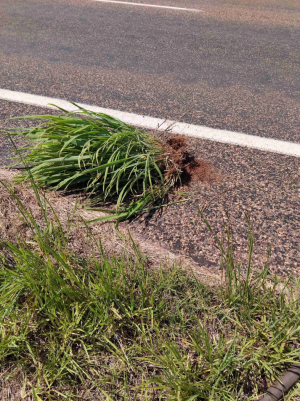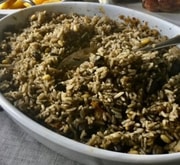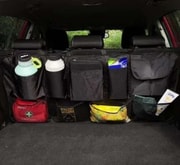New roadside danger puts Aussie drivers at risk: 'It's just really concerning'
By
Gian T
- Replies 0
If you’re planning a road trip through Western Australia’s stunning Kimberley region—or even just popping out for a drive—you might want to keep your eyes peeled for more than just kangaroos and breathtaking scenery.
Authorities have issued a fresh warning about a dangerous invader lurking on the side of Aussie roads that is causing a real headache for locals, landowners, and environmentalists alike—and it could be putting you, your property, and our precious native wildlife at risk.
Gamba grass was first brought to Australia in the 1940s as a promising feed for cattle.
It seemed like a good idea at the time—after all, it grows fast, forms dense clumps, and can shoot up to a whopping four metres tall!
But as is so often the case with introduced species, things quickly got out of hand.
This towering weed outcompetes our native grasses, pushing them out and reducing the biodiversity that makes our bush so special.
But the real kicker? Gamba grass is a fire starter’s dream (or, more accurately, a firefighter’s nightmare).
When it dries out, it becomes highly flammable, and the fires it fuels can burn five to twenty times more intensely than those started by native grasses.
That means more damage to homes, wildlife, and even human lives.
During routine surveillance in the Kimberley, the Department of Primary Industries and Regional Development (DPIRD) found several immature gamba grass plants along local roads.
While these have been removed, authorities are urging everyone—residents, workers, and travellers alike—to keep an eye out for more.
Lindsay Strange, DPIRD’s regional biosecurity coordinator, explained: 'It has become a significant weed across northern Australia due to its ability to grow to over four metres high and form dense patches, which can burn at high intensity—posing a risk to flora and fauna, livestock and human life.'
Gamba grass was widely promoted to the pasture industry and planted extensively in the 1980s, especially in Queensland, the Northern Territory, and Western Australia.
Despite being listed as a weed of national significance in 2012, it’s still spreading.
Experts estimate it could potentially invade 380,000 square kilometres—an area bigger than the entire country of Japan!
Dr Carol Booth from the Invasive Species Council summed up the concern: 'At the moment, gamba grass has invaded about four per cent of the area it could invade, so it’s one of these grasses, where you look into the future, and you just want to cry. It’s just really concerning.'
Aside from the environmental impact, gamba grass poses a direct threat to property and safety.
Fires fuelled by this weed can spread rapidly and are much harder to control. For those living in or travelling through affected areas, the risk is real—especially as we head into the dry season.
If you spot something suspicious, don’t just drive by! Reporting sightings is crucial to stopping the spread of the disease.
You can easily report Gamba grass through the DPIRD’s MyPestGuide Reporter app or by calling their Pest and Disease Information Service on (08) 9380 3080.
WA authorities are working hard to eradicate this weed, but they can’t do it alone. Public vigilance is key.
Whether you’re a local, a grey nomad, or just passing through your eyes and ears can make a real difference.
 Have you had to deal with invasive weeds on your property? Do you have advice for fellow members on how to spot and report them? Share your experiences in the comments below.
Have you had to deal with invasive weeds on your property? Do you have advice for fellow members on how to spot and report them? Share your experiences in the comments below.
Read more: Favourite garden plant hides danger to pets—discover which one is deadly
Authorities have issued a fresh warning about a dangerous invader lurking on the side of Aussie roads that is causing a real headache for locals, landowners, and environmentalists alike—and it could be putting you, your property, and our precious native wildlife at risk.
Gamba grass was first brought to Australia in the 1940s as a promising feed for cattle.
It seemed like a good idea at the time—after all, it grows fast, forms dense clumps, and can shoot up to a whopping four metres tall!
But as is so often the case with introduced species, things quickly got out of hand.
This towering weed outcompetes our native grasses, pushing them out and reducing the biodiversity that makes our bush so special.
But the real kicker? Gamba grass is a fire starter’s dream (or, more accurately, a firefighter’s nightmare).
When it dries out, it becomes highly flammable, and the fires it fuels can burn five to twenty times more intensely than those started by native grasses.
That means more damage to homes, wildlife, and even human lives.
During routine surveillance in the Kimberley, the Department of Primary Industries and Regional Development (DPIRD) found several immature gamba grass plants along local roads.
While these have been removed, authorities are urging everyone—residents, workers, and travellers alike—to keep an eye out for more.
Lindsay Strange, DPIRD’s regional biosecurity coordinator, explained: 'It has become a significant weed across northern Australia due to its ability to grow to over four metres high and form dense patches, which can burn at high intensity—posing a risk to flora and fauna, livestock and human life.'
Gamba grass was widely promoted to the pasture industry and planted extensively in the 1980s, especially in Queensland, the Northern Territory, and Western Australia.
Despite being listed as a weed of national significance in 2012, it’s still spreading.
Dr Carol Booth from the Invasive Species Council summed up the concern: 'At the moment, gamba grass has invaded about four per cent of the area it could invade, so it’s one of these grasses, where you look into the future, and you just want to cry. It’s just really concerning.'
Aside from the environmental impact, gamba grass poses a direct threat to property and safety.
Fires fuelled by this weed can spread rapidly and are much harder to control. For those living in or travelling through affected areas, the risk is real—especially as we head into the dry season.
If you spot something suspicious, don’t just drive by! Reporting sightings is crucial to stopping the spread of the disease.
WA authorities are working hard to eradicate this weed, but they can’t do it alone. Public vigilance is key.
Whether you’re a local, a grey nomad, or just passing through your eyes and ears can make a real difference.
Key Takeaways
- Residents, workers and travellers in the Kimberley region of WA are being warned to watch out for invasive gamba grass after recent detections along local roads.
- Gamba grass, introduced initially from Africa to feed cattle, is now a dangerous environmental weed that grows in tall, dense clumps and dramatically increases bushfire risk.
- Authorities say the weed has already infested parts of Queensland, the Northern Territory and WA and could potentially invade an area larger than Japan if not controlled.
- The public is urged to report any sightings of gamba grass to the Department of Primary Industries and Regional Development to help with eradication efforts.
Read more: Favourite garden plant hides danger to pets—discover which one is deadly








